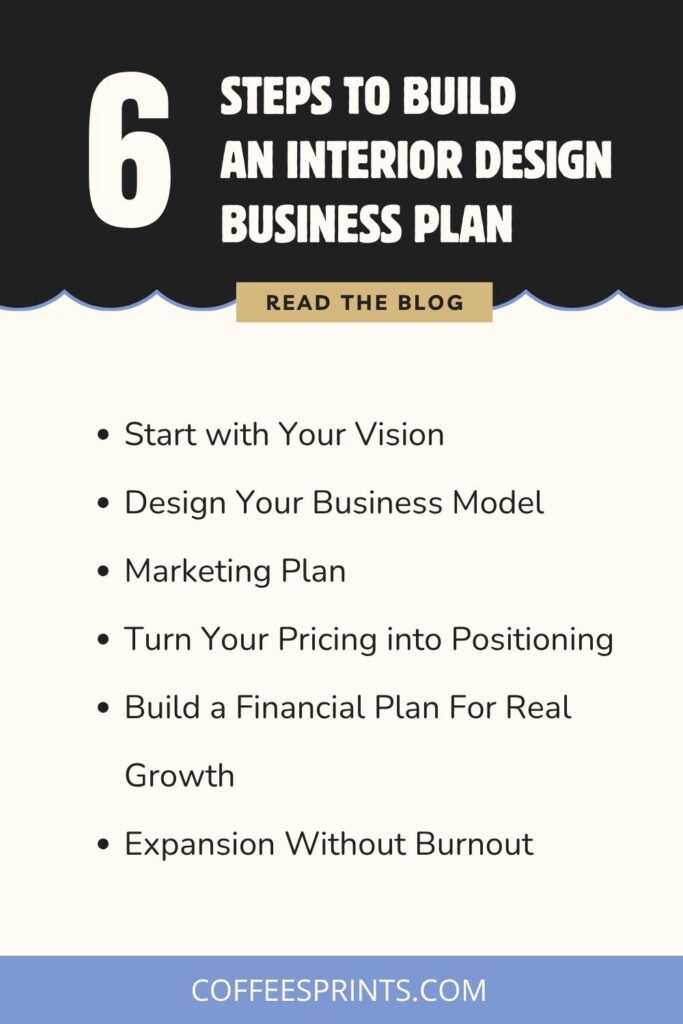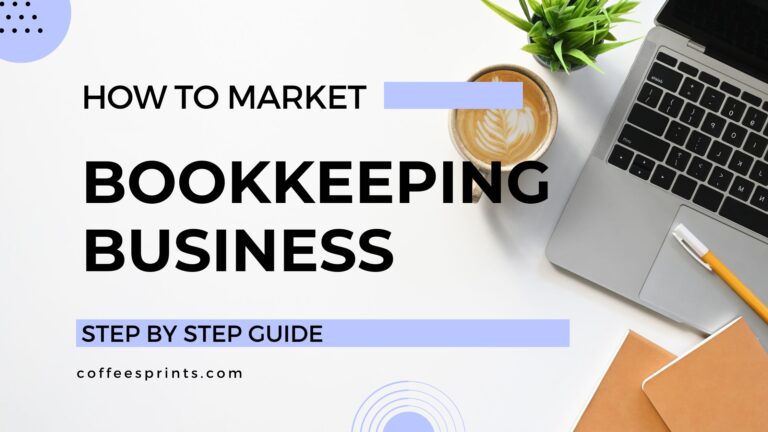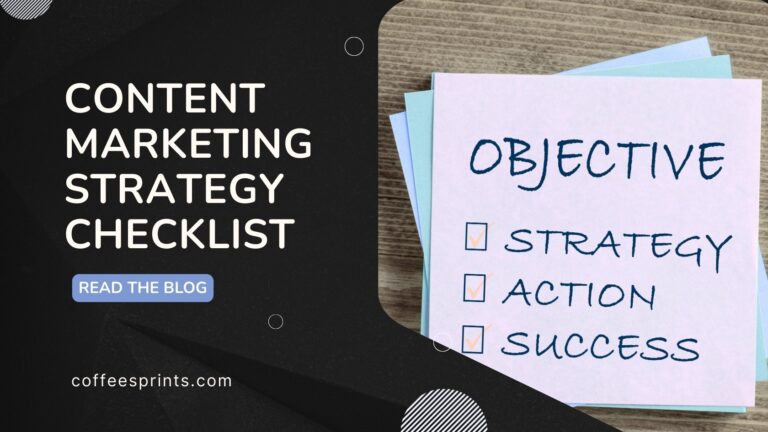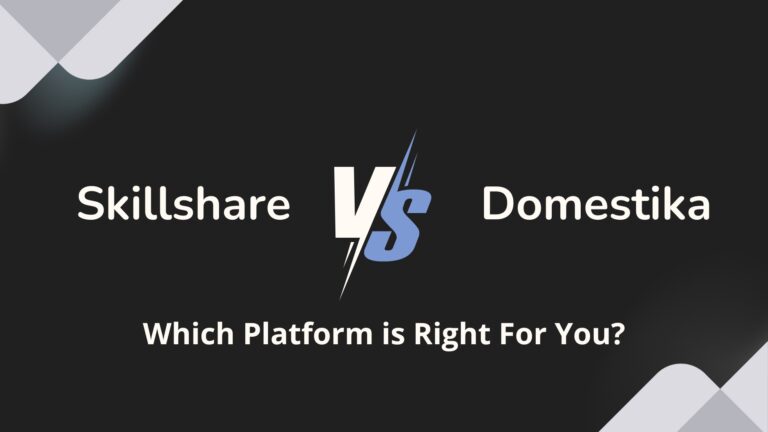How to Build an Interior Design Business Plan That Gets You Clients and Cash Flow
Your business plan has one job: connect your creative vision to revenue clarity.
This means answering questions like:
- How does your design aesthetic attract specific clients?
- What’s the relationship between your creative process and your profit margins?
- Which marketing channels actually convert browsers into paying clients?
- How do you price projects to reflect both expertise and positioning?
A strategy-led business plan gives you leverage. It becomes your foundation for marketing, pricing justifications during client consultations, and evaluating partnerships. It’s not a static document. It’s a working framework that guides daily decisions.
I believe a business plan should do more than impress investors; it should move your business forward.
This article walks you through how to build an interior design business plan that brings clarity to your goals, improves visibility, and drives steady sales growth.
The Real Reason Most Interior Design Business Plans Don’t Work
Before we get into what actually makes a strong business plan, let’s be honest, you’ve probably downloaded the templates, filled out the same old PDFs with generic numbers, and filed them away somewhere between your client folders and material swatches.
That document isn’t helping your design firm grow.
Most of the time, they’re usually borrowed from firms ten times your size, working in completely different markets.
If you’re running a growing interior design studio, trying to mirror a corporate plan built for a 20-person agency is like using someone else’s floor plan for your dream home — it just doesn’t fit.
What you need instead is a business plan that gives you clarity — one that connects your creative vision to visibility, structure, and consistent revenue growth.
That’s exactly what we’ll walk through in this guide.
Start with Your Core Vision, Not Just Numbers

Most interior design startup business plans begin backward. They start with made-up financial projections, then try to reverse-engineer a creative vision that justifies those figures.
Start with clarity about the firm you’re building.
Define your focus:
- Boutique luxury studio for high-net-worth residential clients?
- Minimalist practice for urban apartments?
- Commercial interiors specializing in hospitality?
- Sustainable design consultancy prioritizing eco-friendly materials?
Your creative direction shapes everything: client base, pricing model, marketing message, profit potential. A designer specializing in coastal luxury homes needs a completely different business model than one designing Scandinavian-inspired rental properties.
Map the connection:
If your aesthetic is modern farmhouse → you’re attracting suburban families with $75K-$200K renovation budgets.
If you focus on industrial loft conversions → you’re targeting urban professionals who value open-plan living.
Each direction leads to different service packages, pricing structures, and marketing channels.
Recommended Read:
50+ Content Ideas For Interior Designers to Showcase Your Expertise
How to Find High-Ticket Interior Design Clients: The Complete Guide
Write Your North Star Statement
This is your brand promise—the single sentence that defines what you deliver and why it matters. Not fluffy words like “transform” and “inspire.” A clear positioning statement connecting design philosophy to client outcomes.
Examples:
- “I design calming, functional spaces for overwhelmed parents who need their homes to work as hard as they do.”
- “I create bold commercial interiors that help hospitality brands stand out in oversaturated markets.”
- “I specialize in eco-luxury residential projects where sustainability never compromises style.”
This statement becomes your filter. Every service, every project, every marketing message should align with this core vision.
The strategic link: Your aesthetic → attracts specific client type → predictable project budgets → informs pricing strategy → determines revenue potential → shapes profitable services.
You can’t build an accurate financial plan without this foundation. And you can’t market effectively if you’re trying to be everything to everyone.
Design Your Business Model Like You’d Design a Room
When you walk into an empty room, you don’t throw furniture around randomly. You assess the space, identify function, map traffic flow, create zones. Your business plan for an interior design company deserves the same approach.
Most business plans list services in boring bullets: “Space Planning. Color Consultation. Furniture Selection.” This tells clients and partners nothing about how you work or what makes your process valuable.
Map your design process visually. Show exactly how each stage creates value and generates revenue.
Three-Stage Workflow Example:
Note: This example is just for your understanding. You can tailor it based on your actual business.
Stage 1: Discovery & Concept (Weeks 1-2)
- Initial consultation and space assessment
- Client lifestyle interview and needs analysis
- Mood board and concept presentation
- Design agreement and retainer collection
Time: 8-12 hours | Revenue: $1,500-$3,500 design fee | Costs: Your time, digital tools, samples
Stage 2: Design Development (Weeks 3-6)
- Detailed floor plans and elevations
- Material and finish selections
- Furniture sourcing and specification
- Contractor coordination and quotes
Time: 20-30 hours | Revenue: $3,000-$8,000 (percentage or flat fee) | Costs: Software, vendor relationships
Stage 3: Implementation & Installation (Weeks 7-12)
- Purchase orders and procurement
- Site visits and contractor oversight
- Installation coordination and styling
- Final walk-through and photography
Time: 15-25 hours | Revenue: Project management fee or markup | Costs: Travel, shipping oversight, installation support
Now you can see your business model clearly. Each phase has measurable inputs (time and costs) and outputs (deliverables and revenue). You’re not guessing at profitability—you can calculate which project phases are most profitable per hour and where you’re losing money.
This breakdown does three things:
- Identifies bottlenecks and inefficiencies
- Creates pricing based on actual value delivery, not arbitrary hourly rates
- Becomes a marketing tool when explaining your services to clients or partners
Build this as an actual diagram in your business plan. Use your design skills to create a visual flowchart showing the client journey and business operations. When someone asks how your firm works, you hand them something professional that proves you understand your operations.
Your business model isn’t separate from your design work. It is your design work applied to how you run your firm.
Your Marketing Plan Should Feel Like Your Portfolio
Interior designers don’t need another “post 3x per week on Instagram” strategy. You need a marketing ecosystem that actually attracts high-value clients.
Most design firms treat marketing as an afterthought—posting pretty room photos with no strategy behind them. Then they wonder why inquiries don’t convert or why they’re only attracting budget-conscious clients.
Your marketing plan needs three layers that work together:
1. Authority Content
This is how potential clients discover you exist and trust your expertise before they ever contact you.
What works for interior designers:
- Project storytelling – Write about specific design challenges you solved (not just “before and after” captions)
- Design walk-throughs – Explain your decision-making process for material choices, spatial planning, and lighting
- Local SEO content – “Best interior designers in [your city]” or “[Style] interior design for [neighborhood]”
- Pinterest strategy – Organized boards showcasing your work by room type, style, or budget range
2. Connection Platforms
Authority content attracts strangers. Connection platforms turn them into warm leads.
What builds relationships:
- Email newsletters – Monthly project updates, design insights, or behind-the-scenes stories (not promotional blasts)
- Strategic referrals – Relationships with real estate agents, architects, and contractors who work with your ideal clients
- Local collaborations – Partner with furniture stores, showrooms, or home brands for co-marketing
One referral from a trusted real estate agent is worth more than 1,000 Instagram followers. Build these relationships intentionally.
3. Conversion Assets
These are the materials that turn interested people into paying clients.
Essential conversion tools:
- Service-specific landing pages – Separate pages for “Kitchen Remodels,” “Full Home Design,” “E-Design Packages”
- Professional proposals – Templates that showcase your process, pricing structure, and project timeline
- Lead magnets – Free resources like “Budget Planning Guide for Home Renovations” or “Design Style Quiz”
Your website should make it dead simple for someone to understand what you offer, how much it costs (at least ballpark), and how to start working with you.
Set a realistic marketing cadence:
If you’re a solo designer, you don’t have time for daily content creation. Pick a sustainable rhythm:
- 1 detailed blog post or project feature per month
- 2 newsletter sends per month
- 4-6 social posts per week (batched and scheduled)
- 1 new referral relationship conversation per week
Turn Your Pricing into a Positioning Strategy
Your pricing plan isn’t just a numbers exercise — it’s one of the clearest expressions of your brand positioning.
What and how you charge tells clients exactly where you fit in the market and what level of service they can expect.
Most designers either undercharge because they’re afraid to lose clients, or they price by comparing themselves to competitors instead of understanding their own costs and value.
Strategic pricing helps you do two things:
- Attract the right type of clients.
- Build confidence in the value of your time, process, and creative expertise.
The Value-Tier Pricing Model
Structure your services in ascending tiers that reflect project scope, investment level, and client commitment.
Tier 1: Single-Room Design
- Ideal for clients testing your process
- Low-risk entry point with quick turnaround
- Common spaces: bedrooms, home offices, small living areas
Tier 2: Multi-Room or Full-Home Projects
- Your core business and highest profit margin
- Full design process: concept → sourcing → installation
- Builds credibility and long-term referrals
Tier 3: Design Consulting or Retainer Packages
- For clients who need ongoing design support (developers, realtors, or commercial spaces)
- Predictable monthly revenue that stabilizes cash flow
- Keeps client relationships active between large projects
Introduce Design Fees and Deposits
Charging for your time and expertise from the first meeting sets expectations and filters out non-serious leads.
- Initial Consultation Fee: $150–$500 (credited toward a project if they move forward)
- Design Deposit: 30–50% upfront before work begins
- Milestone Payments: Tie each payment to project stages — concept approval, sourcing, installation — rather than completion
This pricing structure filters out tire-kickers, increases commitment, and signals that you operate like a professional firm, not a freelancer.
Example: A designer who repositioned from “$75/hour” to “Full kitchen design packages starting at $8,500” saw immediate improvement in inquiry quality — same service, elevated perception.
Why This Matters in Your Business Plan
Your pricing section should help readers (and you) see how revenue connects to value.
It’s not about charging the most — it’s about charging appropriately for your expertise, market positioning, and the transformation you deliver.
Build a Financial Plan That Reflects Real Growth
Your financial plan is not the same as your pricing strategy.
Where pricing defines perception and sales approach, your financial plan shows the operational backbone — how your business actually sustains itself and grows profitably.
Most designers use industry-average projections or borrowed templates that ignore real capacity, costs, and margins.
Instead, base your plan on actual project flow, realistic expenses, and measurable growth stages.
Project-Based Revenue Forecasting
Use this simple formula to calculate expected revenue:
Annual Revenue = Number of Projects × Average Project Value
Example:
If you can manage 8–12 residential projects per year, and your average project value is $15,000,
Then your annual projected revenue = $120,000–$180,000.
Now factor in your real costs — software, subcontractors, insurance, samples, travel, marketing, and admin expenses — to calculate your true profit potential.
Financial Planning Formula
Step 1: Estimate gross revenue
Step 2: Subtract variable costs (materials, labor, commissions)
Step 3: Subtract fixed costs (rent, tools, insurance, marketing)
Step 4: Result = Net profit (pre-tax income)
Profit Margin Calculation:
Net Profit Margin (%) = (Net Profit ÷ Total Revenue) × 100
Industry Benchmarks for Interior Design Firms (U.S.)
Keep in mind that these numbers vary by services, location, and the type of clients you serve, but they provide a realistic estimate for your assumptions:
| Metric | Average Range | Notes |
| Gross Profit Margin | 35%–55% | Typical for service-based design work |
| Net Profit Margin | 10%–25% | Strong firms maintain 15%–20% |
| Overhead Ratio | 25%–40% of revenue | Includes rent, admin, marketing |
| Average Annual Revenue (Solo Designer) | $100K–$250K | Depends on location & client base |
| Established Firm (3–5 staff) | $500K–$1M+ | With steady pipeline and referrals |
What to Include in the Financial Section of Your Business Plan
- Revenue Forecasts: Based on the number and type of projects
- Expense Breakdown: Variable + fixed costs
- Profit Projections: By service tier or client type
- Growth Plan: Revenue targets tied to capacity (e.g., hiring a junior designer or outsourcing admin)
- Cash Flow Plan: Timeline for receiving and reinvesting payments
A realistic financial plan doesn’t impress with big numbers — it reassures clients, partners, and you that your business can sustain and scale responsibly.
Future-Proofing: Expansion Without Burnout
Your interior design firm’s business plan should map growth realistically, not aspirationally.
Most designers write business plans that say “grow to $500K revenue in 3 years” without explaining how they’ll actually get there. No hiring plan. No capacity analysis. No consideration for the fact that you’re already working 50-hour weeks.
Plan your growth path in stages: solo designer, designer + VA; Small teams
Build a referral network early:
If you’re in the interior business for a while, you might’ve already known the power of referrals. It comes from strategic relationships with people who already have your ideal clients’ attention:
- Real estate agents specializing in homes that match your price range and style
- Architects who need interior design partners for their projects
- General contractors who work on the type of renovations you design
- Local furniture stores or showrooms where your clients already shop
- Wedding planners, home stagers, or photographers in adjacent industries
Treat these like actual partnerships. Refer business to them. Feature their work. Create co-marketing opportunities. From my experience, I’ve seen businesses generating over 5-10 qualified leads per year with just one strong referral partner.
Wrapping it up!
Your business plan shouldn’t sit in a drawer. It should be the framework that guides every decision, every price conversation, and every growth opportunity.
So build one that actually works.






